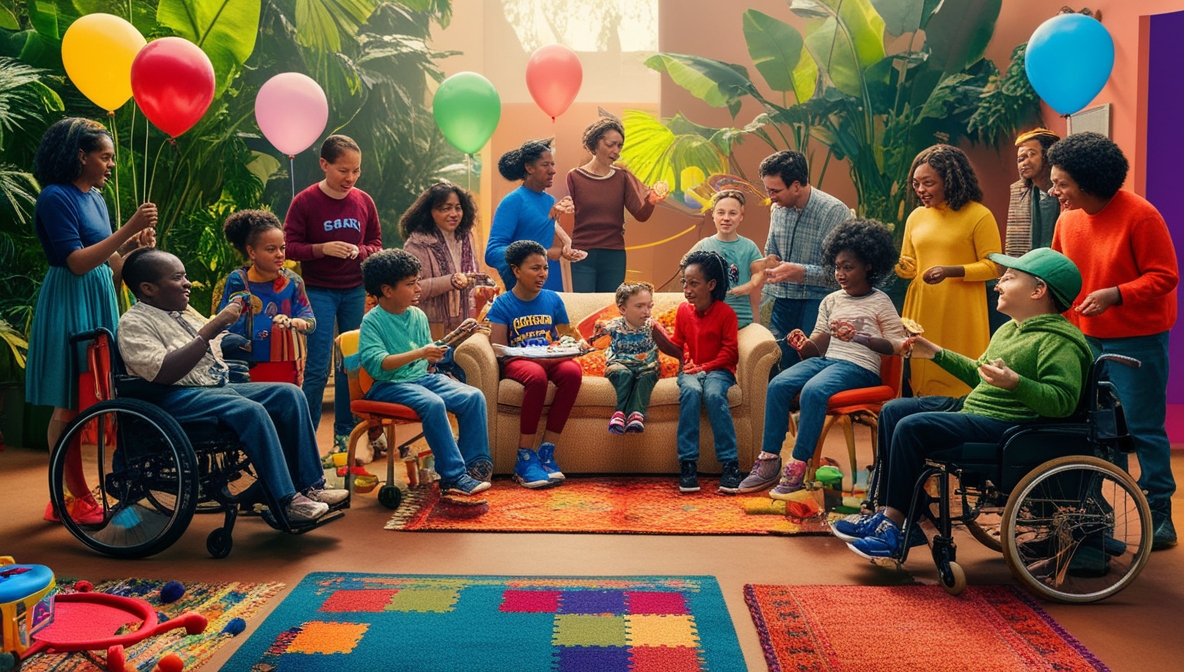When my nephew was diagnosed with autism spectrum disorder (ASD), our family felt a mix of emotions. We were overwhelmed, uncertain, and, frankly, a bit scared. Understanding the different types of autism seemed like an impossible task. But as we learned more, our fear became a quest for knowledge and compassion. We realized that understanding the different types of autism is crucial for providing the right support and ensuring that every child with autism can lead a fulfilling life.
Autism spectrum disorders affect millions of people worldwide. Each type of autism has its own set of challenges and strengths, from classic autism to Asperger’s syndrome. Each form has unique characteristics that shape how individuals interact with the world. Learning about these differences fosters empathy, improves social interactions, and promotes positive behaviors.
In this article, we will explore the five different types of autism: Classic Autism (Autistic Disorder), Asperger Syndrome, Pervasive Developmental Disorder-Not Otherwise Specified (PDD-NOS), Childhood Disintegrative Disorder (CDD), and Rett syndrome. We will discuss their defining traits and common symptoms and share personal stories highlighting the human side of these conditions.
Type 1: Classic Autism (Autistic Disorder)

Definition and Characteristics
Classic Autism, also known as Autistic Disorder, is the most well-known form of autism spectrum disorder (ASD). Significant challenges in social interaction, communication skills, and repetitive behaviors characterize it. Children with classic autism often show delays in language development and have difficulties in forming relationships and understanding social cues.
Common Symptoms and Behaviors
Individuals with classic autism might display the following:
Delayed language development or lack of spoken language
Difficulty with social interactions, such as making eye contact or understanding facial expressions
Repetitive behaviors like hand-flapping, rocking, or lining up objects
Strong preference for routines and resistance to changes
Limited range of interests, often focusing intensely on specific topics or activities
Sensory sensitivities to lights, sounds, or textures
Personal Stories or Examples
Consider Jack, a bright six-year-old boy who loves trains. From an early age, his parents noticed that Jack didn’t respond to his name and rarely made eye contact. When he did speak, he often repeated lines from his favorite train show instead of using his own words. Jack’s parents felt isolated and worried until they received his diagnosis of classic autism.
Jack has made remarkable progress with early intervention and speech and occupational therapy support. He now uses simple sentences to express his needs and enjoys playing alongside other children, even if he doesn’t always interact directly with them. Jack’s story highlights the importance of understanding and supporting children with autistic disorders to help them achieve their potential.
Type 2: Asperger Syndrome

Definition and Characteristics
Asperger Syndrome is a type of autism spectrum disorder (ASD). Unlike classic autism, individuals with Asperger Syndrome typically do not have significant delays in language development or cognitive abilities. However, they may face challenges in social interactions and exhibit repetitive behaviors. People with Asperger Syndrome often have strong intellectual abilities and may develop deep knowledge in specific areas of interest.
Differences from Classic Autism
Language Skills: Unlike those with classic autism, individuals with Asperger Syndrome usually have normal to above-average language development. They can speak fluently but might struggle with the subtleties of communication, such as understanding sarcasm or idioms.
Cognitive Abilities: People with Asperger Syndrome often have strong intellectual skills and may excel in academic areas. In contrast, individuals with classic autism might have more varied cognitive abilities.
Social Interaction: While both groups may have difficulties with social skills, those with Asperger Syndrome often want to interact with others but may not know how to do so appropriately. They might appear awkward or may not understand social norms.
Repetitive Behaviors: Both groups exhibit repetitive behaviors, but individuals with Asperger Syndrome might have intense interests in specific subjects, such as math, science, or particular hobbies.
Real-Life Examples and Success Stories
Take Tom, a teenager who has always been interested in computers. He was diagnosed with Asperger Syndrome when he was eight years old. While Tom excelled academically, he struggled with making friends and understanding social cues. His parents sought help from social skills groups and behavioral therapy, which taught Tom how to interact better with his peers.
Today, Tom is a successful software engineer at a leading tech company. His deep knowledge of programming and his ability to focus intensely on his work has made him a valuable team member. Tom’s story illustrates how individuals with Asperger Syndrome can leverage their strengths and succeed with the right support.
Type 3: Pervasive Developmental Disorder-Not Otherwise Specified (PDD-NOS)

Definition and Characteristics
Pervasive Developmental Disorder-Not Otherwise Specified (PDD-NOS) is a type of autism spectrum disorder (ASD). It is sometimes referred to as atypical autism because it doesn’t fully meet the diagnostic criteria for classic autism or Asperger Syndrome. Individuals with PDD-NOS exhibit some, but not all, of the traits associated with autism. They may have challenges with social interactions and communication skills and exhibit repetitive behaviors, but these symptoms can vary widely in severity.
How It Fits Within the Autism Spectrum
PDD-NOS is considered a spectrum disorder because it includes a range of symptoms that do not fit neatly into other categories of autism. It is often diagnosed when an individual shows autistic-like behavior but does not meet the full criteria for other specific types of autism, such as classic autism or Asperger Syndrome. The diagnosis of PDD-NOS acknowledges that the person has a developmental disorder that impacts their social and communication skills but in a less defined way.
Personal Anecdotes or Case Studies
Meet Alex, a seven-year-old boy who loves dinosaurs. Alex was diagnosed with PDD-NOS at the age of four. His parents noticed that while he had good language skills, he struggled to interact with other children and often played alone. He exhibited some repetitive behaviors, such as lining up his toy dinosaurs, but did not have the more severe symptoms associated with classic autism.
Alex’s parents enrolled him in a specialized program to improve his social and communication skills. With the help of speech therapy and occupational therapy, Alex has made significant progress. He now participates in group activities at school and has started to make friends. Alex’s story shows how children with PDD-NOS can benefit from early intervention and tailored support to help them thrive.
Type 4: Childhood Disintegrative Disorder (CDD)

Definition and Characteristics
Childhood Disintegrative Disorder (CDD), also known as Heller’s Syndrome, is a rare and severe type of autism spectrum disorder (ASD). Children with CDD develop normally for at least the first two years of life, achieving typical milestones in language development, social skills, and motor abilities. However, after this period of normal development, they experience a significant and rapid loss of these skills. This regression can profoundly affect communication skills, social interactions, and behavioral skills.
How It Differs from Other Types of Autism
Age of Onset: Unlike other types of autism, which are often evident in early infancy, CDD manifests after a period of normal development, typically between ages 2 and 4.
Severity of Regression: The loss of previously acquired skills in CDD is more severe and rapid compared to other forms of autism, such as classic autism or Asperger Syndrome.
Functional Decline: Children with CDD often lose basic skills, including language skills, bladder and bowel control, and motor abilities, which is not commonly seen in other types of autism.
Emotional Impact on Families
The sudden and severe nature of CDD can be devastating for families. Imagine the heartbreak of seeing your child develop normally, only to watch them lose the skills they worked so hard to achieve. This rapid regression can leave parents feeling confused, helpless, and deeply saddened.
Take the story of Mia, a three-year-old girl who was hitting all her developmental milestones. She could speak in full sentences, enjoyed playing with her peers, and even began reading simple books. But at age four, Mia started to regress. She lost her ability to speak, stopped playing with other children, and no longer responded to her parents in the same way. Mia’s parents were overwhelmed with grief and uncertainty about their daughter’s future.
They sought help from medical professionals and enrolled Mia in various therapies, including speech therapy, occupational therapy, and applied behavior analysis (ABA). These interventions improved, but the emotional toll on the family was significant. Mia’s parents had to adjust their expectations and find new ways to connect with their daughter. They also sought support from other families dealing with CDD, which helped them feel less alone in their journey.
Type 5: Rett Syndrome

Definition and Characteristics
Rett Syndrome is a rare genetic disorder that affects brain development, primarily in girls. Mutations in the MECP2 gene on the X chromosome cause it. Children with Rett Syndrome typically develop normally for the first 6 to 18 months. After this period, they experience a loss of acquired skills such as speech, motor abilities, and purposeful hand movements. Rett Syndrome is often included in autism spectrum disorders because it shares some similar characteristics, such as difficulties with social interactions and communication skills.
Unique Features and Challenges
Involuntary Hand Movements: One of the hallmark features of Rett Syndrome is repetitive hand movements, such as wringing, clapping, or tapping.
Loss of Motor Skills: Children with Rett Syndrome often lose the ability to walk, use their hands, and perform other motor functions.
Communication Difficulties: Speech is severely impaired, and many individuals with Rett Syndrome may be nonverbal, relying on eye gaze and other nonverbal communication methods.
Breathing Problems: Irregular breathing patterns, including hyperventilation and breath-holding, are common in Rett Syndrome.
Seizures: Many children with Rett Syndrome experience seizures, which can complicate their overall health and development.
Scoliosis: Curvature of the spine is a common complication, often requiring medical intervention.
Inspirational Stories and Advancements in Treatment
Sophia’s story is a beacon of hope for many families dealing with Rett Syndrome. Diagnosed at age two, Sophia quickly lost her ability to speak and use her hands. Her parents were devastated but determined to find ways to improve her quality of life. They explored various therapies, including physical, speech, and occupational therapy.
Sophia’s parents also became involved in research initiatives to find treatments and potential cures for Rett Syndrome. Recent advancements in gene therapy have shown promise in reversing some symptoms of Rett Syndrome in animal models. Thanks to these breakthroughs, future treatments that could significantly better the lives of those who suffer from this condition are now possible.
Sophia now uses a communication device that tracks her eye movements, allowing her to “speak” with her family. She enjoys music therapy and swimming, which help with her motor skills and provides her with joy and relaxation. Sophia’s story highlights the importance of persistence, love, and the ever-evolving field of medical research in improving the lives of those with Rett Syndrome.
Living with Autism
Daily Challenges and Triumphs
Living with autism spectrum disorder (ASD) presents both challenges and triumphs for individuals and their families. Daily life can be demanding, but it is also filled with moments of joy and achievement.
Challenges:
Communication Difficulties: Many individuals with autism struggle with expressing their needs and understanding others, leading to frustration and misunderstandings.
Social Interactions: Forming and maintaining relationships can be difficult due to challenges with social cues and norms.
Sensory Sensitivities: Everyday environments can be overwhelming due to heightened sensitivities to sounds, lights, or textures.
Routine and Change: Many people with autism thrive on routine and may find unexpected changes distressing.
Behavioral Issues: Repetitive and challenging behaviors can interfere with daily activities.
Triumphs:
Small Victories: Achieving a new skill, whether tying shoelaces or learning to say a new word, can be monumental.
Unique Talents: Many individuals with autism have exceptional abilities in math, music, art, or memory.
Personal Growth: Progress in social skills, communication skills, and independence can significantly improve quality of life.
Tips for Families and Caregivers
Supporting a loved one with autism requires patience, understanding, and practical strategies. Here are some tips for families and caregivers:
1. Early Diagnosis and Intervention: To support development, seek an early diagnosis and start interventions such as speech therapy, occupational therapy, and applied behavior analysis (ABA).
2. Consistent Routine: Establish and maintain a consistent daily routine for stability and predictability.
3. Visual Aids: Use visual schedules and cues to help with transitions and understanding daily activities.
4. Positive Reinforcement: Encourage and reward positive behaviors to reinforce desired actions and skills.
5. Create a Calm Environment: Minimize sensory overload by creating a calm, structured environment at home.
6. Educate Yourself: Learn about autism and stay informed about new research and strategies.
7. Self-Care: Caregivers should also take time for self-care to maintain their well-being.
Resources and Support Networks
Finding the right resources and support networks can make a significant difference for families dealing with autism:
Autism Speaks: Offers resources, support, and advocacy for individuals with autism and their families.
Local Support Groups: Join local support groups to connect with other families and share experiences and advice.
Therapy Services: Access services such as speech therapy, occupational therapy, physical therapy, and family therapy to support development and well-being.
Educational Programs: Enroll in specialized educational programs that cater to the needs of children with autism.
Online Communities: Participate in online forums and social media groups to connect with others and find resources.
Healthcare Professionals: Work with healthcare professionals, including medical professionals and therapists, to develop and implement effective treatment plans.
Living with autism involves navigating challenges, celebrating successes, and accessing a wide range of resources and support. With the right approach, individuals with autism can lead fulfilling and meaningful lives.
Conclusion
Understanding the different types of autism is crucial for fostering empathy and providing the appropriate support for individuals with autism spectrum disorder (ASD). Here is a recap of the five types of autism discussed:
Classic Autism (Autistic Disorder): Characterized by significant challenges in social interaction, communication skills, and repetitive behaviors.
Asperger Syndrome: Individuals with this disorder typically have strong language and cognitive skills but struggle with social interactions and may exhibit intense interests.
Pervasive Developmental Disorder-Not Otherwise Specified (PDD-NOS): A spectrum disorder that includes a range of symptoms not fully meeting the criteria for other specific types of autism.
Childhood Disintegrative Disorder (CDD): Marked by a severe and rapid loss of previously acquired skills after a period of normal development.
Rett Syndrome: A genetic disorder primarily affecting girls, leading to severe impairments in motor skills and communication abilities.
The Importance of Awareness and Empathy
Increasing awareness and understanding of the different types of autism helps create a more inclusive and supportive society. Empathy plays a vital role in this process. When we take the time to learn about the experiences of individuals with autism and their families, we can better appreciate their challenges and triumphs. This understanding fosters a more compassionate approach, encouraging acceptance and reducing stigma.
Encouragement for Readers to Seek More Information and Support
It is crucial for those who suffer from autism to seek out support and information. Early diagnosis and intervention can significantly improve outcomes. Resources such as speech therapy, occupational therapy, and support networks can provide much-needed assistance. Organizations like Autism Speaks offer valuable resources and advocacy.
Whether you are a parent, caregiver, educator, or simply someone wanting to learn more, there are many ways to support individuals with autism. By educating ourselves and spreading awareness, we can help ensure that everyone with autism receives the understanding, respect, and support they deserve.






Leave a Reply